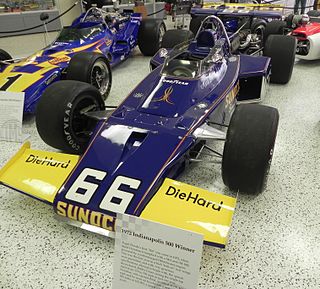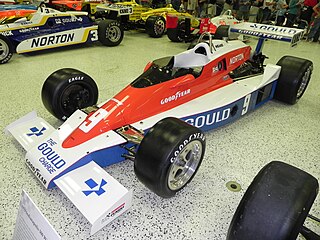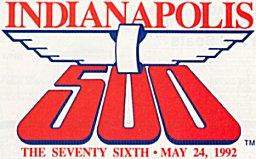
Rodger Morris Ward was an American racing driver best known for his open-wheel career. He is generally regarded as one of the finest drivers of his generation, and is best known for winning two National Championships, and two Indianapolis 500s, both in 1959 and 1962. He also won the AAA National Stock Car Championship in 1951.
This article discusses the year-by-year history of the Indianapolis 500 race.

The 52nd International 500 Mile Sweepstakes was held at the Indianapolis Motor Speedway in Speedway, Indiana on Thursday May 30, 1968. For the second year in a row, one of Andy Granatelli's STP Turbine-powered machines was leading late in the race, but once again, it failed within sight of victory.

The Lotus 38 was the first rear-engined car to win the Indianapolis 500, in 1965, driven by Jim Clark. It was run by Lotus at Indianapolis from 1965 to 1967; a total of 8 were built, most for use by Lotus, but several were sold for use by other drivers, including A. J. Foyt and Mario Andretti.

The 54th 500 Mile International Sweepstakes was held at the Indianapolis Motor Speedway in Speedway, Indiana on Saturday, May 30, 1970.

The 56th 500 Mile International Sweepstakes was held at the Indianapolis Motor Speedway in Speedway, Indiana, on Saturday, May 27, 1972. The race is notable in that for the first time, the cars were permitted bolt-on wings, and speeds climbed dramatically. Bobby Unser won the pole position at a then-remarkable speed of 195.940 mph (315.3 km/h) for four laps, breaking Peter Revson's track record of 178.696 mph (287.6 km/h) from 1971 by 17.244 mph (27.8 km/h) – the largest one-year track record increase in Indy history. The race average speed of 162.962 mph (262.3 km/h) was also a new record, which stood until 1984.

The 58th 500 Mile International Sweepstakes was held at the Indianapolis Motor Speedway in Speedway, Indiana on Sunday, May 26, 1974. Johnny Rutherford, in his eleventh attempt, won the race from the 25th starting position, the farthest back since Louis Meyer in 1936. It was the first of his three Indy victories, and started a three-year stretch where he finished 1st-2nd-1st.

The 59th 500 Mile International Sweepstakes was held at the Indianapolis Motor Speedway in Speedway, Indiana on Sunday, May 25, 1975. A. J. Foyt started on the pole position and Bobby Unser won his second Indianapolis 500. Dan Gurney, one of the founders of All American Racers, who finished second as a driver himself in 1968–1969, won his first and only Indy 500 as a car owner. Gurney's Eagle chassis itself scored its third "500" win. The race was part of the 1975 USAC National Championship Trail.

The 61st 500 Mile International Sweepstakes was held at the Indianapolis Motor Speedway in Speedway, Indiana on Sunday, May 29, 1977. Considered one of the most historically significant editions of the Indianapolis 500, several sidebar stories complemented the unprecedented accomplishment of race winner A. J. Foyt. Foyt became the first driver to win the Indianapolis 500 four times. As of 2023, Foyt's record has been tied by Al Unser Sr., Rick Mears and Hélio Castroneves, but still stands as an Indy 500 record. Foyt's victory is also the last time the winning car was built entirely within the United States.

The 62nd 500 Mile International Sweepstakes was held at the Indianapolis Motor Speedway in Speedway, Indiana on Sunday, May 28, 1978. Danny Ongais dominated the early stages of the race but eventually dropped out with a blown engine. Al Unser Sr. dominated the second half, and held a large lead late in the race. However, Unser bent the front wing of his Lola during a pit stop on lap 180, causing his handling to go away over the final twenty laps. Second place Tom Sneva charged to catch Unser's crippled Lola but came up 8 seconds short at the finish line – the second-closest finish in Indy history to that point. Unser held off the challenge, and became a three-time winner of the 500. It was Al Unser's third Indy victory in the decade of the 1970s, and the fifth of nine overall victories by the Unser family.

The 63rd 500 Mile International Sweepstakes was held at the Indianapolis Motor Speedway in Speedway, Indiana, on Sunday May 27, 1979. Second-year driver Rick Mears took the lead for the final time with 18 laps to go, and won his first of four Indianapolis 500 races. It was also Mears' first of a record six Indy 500 pole positions. Brothers Al and Bobby Unser combined to lead 174 of the 200 laps, but Al dropped out around the midpoint, and Bobby slipped to 5th place at the finish nursing mechanical issues. It was also Roger Penske's second Indy 500 victory as a car owner.

The 53rd International 500 Mile Sweepstakes was an auto race held at the Indianapolis Motor Speedway in Speedway, Indiana on Friday, May 30, 1969. It was the third round of the 1969 USAC Championship Car season. Polesitter A. J. Foyt led the race in the early stages, looking to become the first four-time winner of the 500. Near the halfway point, however, a lengthy pit stop to repair a broken manifold put him many laps down. Despite a hard-charging run towards the end, he wound up managing only an eighth-place finish, 19 laps down. Lloyd Ruby, a driver with a hard-luck reputation at the Speedway, was leading the race just after the midpoint. During a pit stop, he pulled away with the fueling hose still attached, ripped a hole in the fuel tank, and was out of the race. The incident put Mario Andretti in the lead for rest of the way.

The 50th International 500-Mile Sweepstakes was held at the Indianapolis Motor Speedway in Speedway, Indiana on Monday, May 30, 1966. The official program cover for the race celebrated both the 50th running of the race, and 150th anniversary of Indiana statehood.

The 48th International 500-Mile Sweepstakes was held at the Indianapolis Motor Speedway in Speedway, Indiana on Saturday, May 30, 1964. The race was won by A. J. Foyt, but is primarily remembered for a fiery seven-car accident which resulted in the deaths of racers Eddie Sachs and Dave MacDonald. It is also the last race won by a front-engined "roadster", as all subsequent races have been won by rear-engined, formula-style cars. It was Foyt's second of four Indy 500 victories.

The 47th International 500-Mile Sweepstakes was held at the Indianapolis Motor Speedway in Speedway, Indiana on Thursday, May 30, 1963. Rufus Parnelli Jones took his only Indy 500 win. This win was controversial because his car spewed oil from a cracked overflow tank for many laps, which allegedly caused at least one driver to spin and crash. USAC officials put off black-flagging Jones after car owner J. C. Agajanian ran down pit lane and convinced them that the oil leak was below the level of a known crack and would not leak any further. Lotus owner Colin Chapman, whose English-built, rear-engined Lotus-Ford finished second in the hands of Scotsman Jim Clark, accused USAC officials of being biased in favor of the American driver and car.

The 64th 500 Mile International Sweepstakes was held at the Indianapolis Motor Speedway in Speedway, Indiana on Sunday, May 25, 1980. Johnny Rutherford won the pole position, led 118 laps, and won the race by a commanding 29.92 second margin. After failing to finish the race the year before, Jim Hall's radical new Chaparral 2K ground effects chassis was a heavy favorite entering the month, and drove a flawless race. Rutherford, the winner in 1974 and 1976, became the sixth driver to win the Indy 500 three times.

The 65th Indianapolis 500 was held at the Indianapolis Motor Speedway in Speedway, Indiana, on Sunday, May 24, 1981. The race is widely considered one of the most controversial races in Indy history. Bobby Unser took the checkered flag as the winner, with Mario Andretti finishing second. After the conclusion of the race, USAC officials ruled that Unser had passed cars illegally while exiting the pit area during a caution on lap 149. Unser was subsequently issued a one-position penalty. The next morning, the official race results were posted, and Unser was dropped to second place. Andretti was elevated to first place and declared the race winner.

The 82nd Indianapolis 500 was held at the Indianapolis Motor Speedway in Speedway, Indiana on Sunday, May 24, 1998. This was the third Indianapolis 500 run as part of the Indy Racing League, but the first fully-sanctioned by the IRL after they relied on USAC to sanction the 1996–1997 races. The race was part of the 1998 Pep Boys Indy Racing League season.

The 76th Indianapolis 500 was held at the Indianapolis Motor Speedway in Speedway, Indiana, on Sunday, May 24, 1992. The race is famous for the fierce battle in the closing laps, as race winner Al Unser Jr. held off second place Scott Goodyear for the victory by 0.043 seconds, the closest finish in Indy history. Unser Jr. became the first second-generation driver to win the Indy 500, following in the footsteps of his father Al Unser Sr. He also became the third member of the famous Unser family to win the race.

The 69th Indianapolis 500 was held at the Indianapolis Motor Speedway in Speedway, Indiana, on Sunday, May 26, 1985. The race was sanctioned by USAC, and was included as part of the 1985 CART PPG Indy Car World Series. The Speedway also celebrated 40 years of ownership by the Hulman/George family.



















